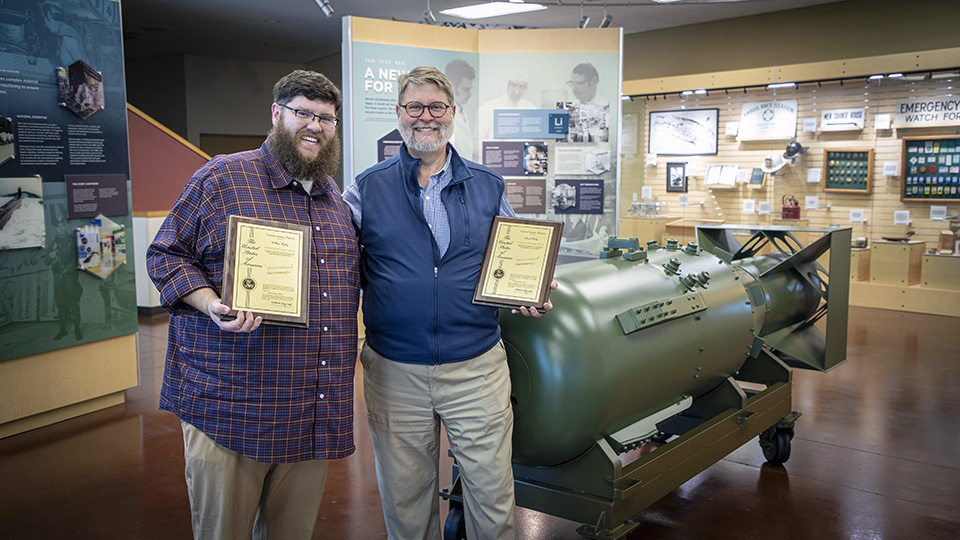Father-son team at Y-12 develop impactful technology

Will (left) and Ed R..(right) showcase the plaques they received for their joint patent, “Method of Making an Annular Radioisotope Target Having a Helical Coil-Shaped Foil Ribbon Between Cladding Tubes.”
As an engineer and researcher for more than 35 years at Y‑12, Ed R. has held many roles. He certainly understands the importance of continuous improvement through constant evaluation, research, and development of new processes and technologies. Working with the Technology Transfer Office, he has spearheaded and received 34 patents stemming from his work.
His most recent patent, though, just might be his favorite.
Forming a father‑son team
Ed’s son, Will, had just started working as a systems engineer in Y‑12 Development at the time Ed had begun working on a project related to annular, or tube‑shaped, radioisotopes. While Will was waiting on his security clearance, Ed thought this project would be a great opportunity for Will to gain experience and learn about Development.
“When this idea came to mind, I jumped at the chance,” said Ed. “It was an opportunity for us to work together on something, while also providing Will with important experience and education.”
They quickly set up a process to work together on the project and met daily.
“Getting the chance to work with my dad on this project was really cool,” said Will, now shift technical advisor. “Having just transferred to Y‑12 and waiting on my clearance, it was an amazing opportunity to do work on new technology while I was working on my prerequisites as a systems engineer.”
Developing a new and improved technology
Process improvement is crucial to the Y‑12 mission, especially when an improved process can save time and increase worker safety. The duo established those goals when they began working on a new method for the annular radioisotope assembly process.
The previous method uses a flat foil that is wrapped into a C‑shape around an inner tubing. The foil then has an outer tube slid over it, and the ends are welded shut to prevent foil movement. The process concludes by expanding the inner and outer tubes to obtain a final desired dimension. This method can cause quality issues with the final product and can increase worker exposure times due to potential buckling of the foil.
“We were able to take an in‑depth look at this labor‑intensive process and then find ways to improve it,” Ed said.
Working together daily, Ed and Will developed an improved and more efficient technology and method. The new method simply cuts the foil that wraps around the inner tube into a helical coil or spring. The helical coil can be twisted to tightly grip the inner tubing with edges on the foil that lock together when tightened. Conducting the process through this new and improved technology prevents gaps and overlaps of the foil that would otherwise hurt the quality of the final product. The helical design speeds up the overall process by eliminating the potential for buckling of the foil, which reduces exposure time to employees.
“This technology brings the ability to create medical isotopes in a repeatable and effective way with an extremely high percentage of usable material and minimal waste,” Will said. “It brings a ton of potential to both the NSE [Nuclear Security Enterprise] and the medical industry.”
Receiving a patent
As the development of this new technology and method were coming to a close, Ed began showing Will how to conduct patent searches to ensure their method was unique and how to ensure it was protected through the Y‑12 Technology Transfer Office.
“Having no experience with the patent process at Y‑12, I was very impressed with how streamlined and simple the process is,” said Will. “The Tech Transfer group knows how to get the ball rolling and help guide you through everything.”
Once it was confirmed that their approach was completely new, they proceeded with filing a patent through the Technology Transfer Office. This patent was Will’s first, and working as a father‑son team made the success that much better.
“I loved every second of it,” Ed said. “Your first patent is truly a milestone, and I have so much pride for Will and how big of an accomplishment this was for him. It’s always great to see your kid succeed, but being able to work together in the process of it all made it so much more meaningful.”
Will said, “I had wanted to work at Y‑12 since I was a little kid. Having grown up hearing about all of the cool projects my dad had been part of, it was extremely special to finally be part of one.”
The new Y‑12 technology can be useful within the NSE, but it has potential to have a large impact within the medical industry as well. Hospitals worldwide use radioisotopes in medicine and for diagnostic scan procedures. Y‑12’s technology is applicable to all isotope productions, so there is potential to commercialize this technology to other industries.
“At Y‑12, we get to go beyond the leading edge of technology,” said Ed. “I’m grateful we get to develop things that people will be using and reading about for decades to come.”
